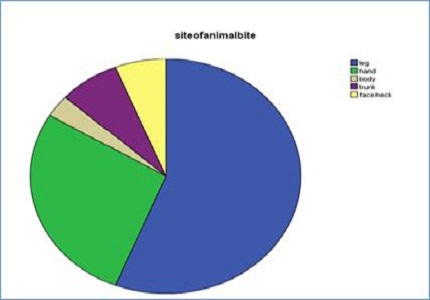An epidemiological study of dog bite cases in a rural area of Salem, Tamil Nadu
Abstract
Introduction: Rabies is a viral zoonosis. In up to 99% of cases, domestic dogs are responsible for rabies virus transmission to humans. About 30% of the victims of dog bites are children under the age of 15.
Objective: To assess the epidemiological pattern of dog bite cases, which formed the majority of cases attending anti-rabies clinic.
Materials and Methods: This study was conducted at the Primary Health Centre, Poolavari, Salem, Tamil Nadu, India between Feb 1st- May 1st2018.It is a cross sectional study, where all dog bite cases attending injection OPD were studied. A questionnaire-based survey was conducted amongst dog bite patients in the Primary Health Centre at Poolavari, Salem.
Results: Highest percentage of dog bite victims belonged to the age group of 5-25Years(33.7%). The bites were mostly by pet dogs (75.5%). 91.8% of the dogs were not vaccinated. Running, patting were the most common factors leading to dog bites (50.0%). 52% of the study population had awareness of first aid for dog bite.88.8% population had awareness about Anti rabies vaccines for dog bites. Most of the victims took the treatment within ½ hr (30.6%). 81.6% of the victims took allopathy treatment.
Conclusion: The study concludes that awareness of first aid for dog bites, pet dog vaccination, awareness about Anti rabies vaccine for dog bites and completion of the treatment should be increased in the rural population.
Downloads
References
2. Hampson K, Coudeville L, Lembo T, Sambo M, Kieffer A, Attlan M, et al. Estimating the global burden of endemic canine rabies. PLoSNeglectedTropical Disease. 2015;9(5):0003786.
3. Sudarshan MK, Madhusudana SN, Mahendra BJ, Rao NS, AshwathNarayana DH, Abdul Rahman S, et al. Assessing the burden of human rabies in India: Results of a National Multi-center Epidemiological survey. Int J Infect Dis. 2007;11:29–35. [PubMed]
4. Sudarshan MK.Assessing burden of rabies in India: WHO sponsored National Multi-centric rabies survey, 2003. Indian Jof Community Medicine 2005;30(3):100-101.
5. WHO Fact Sheet. Geneva 2013: World Health Organization
6. Gogtay NJ, Nagpal A, Mallad A, Patel K, Stimpson SJ, Belur A, et al. Demographics of animal bite victims & management practices in a tertiary care institute in Mumbai, Maharashtra, India. Indian J Med Res. 2014;139(1):459–62. [PubMed]
7. Ghosh A, Pal R. Profile of dog bite cases in an urban area of Kolkata, India. Nat J Community Med. 2014;5(3):321–4.
8. Umrigar P, Parmar GB, Patel PB, Bansal RK. Epidemiology of animal bite cases attending municipal tertiary care centres in Surat city: A cross-sectional study. Nat J Community Med. 2013;4(1):153–7.
9. S.Sangeetha, Sujatha K. Roseline Fatima William.An epidemiological study of animal bites among rural population in Tamil Nadu, India.Int J Community Med Public Health. Jun 2016 ; 3(6); 1413-1418 http://www.ijcmph.com.
10. M.K.Sudarshan, B.J.Mahendra,S.N.Madhusudana, D.H.Ashwath Narayana, Abdul Rahman, N.S.N.Rao,F.X-Meslin, Derek Lobo, K.Ravikumar and Gangaboraiah. An Epidemiological Study of Animal Bites in India : Results of A WHO Sponsored National Multi-Centric Rabies Survey. J. Commun. Dis2006;38 :32-39.
11. Dr. Y. Suba JoiceDr.Zile Singh Dr.Shib Sekhar Datta. Knowledge, Attitude and Practices Regarding Dog Bite and its Management Among Adults in Rural Tamil Nadu.International J of Scientific Research May 2016;5(5):586-589.
12. Sukumar Bharathy, LakshmanasamiGunaseelan. A Cross Sectional Study to Understanding Demographics of Dog Bite Victims Attending Anti Rabies Ward in Chennai City, Tamil Nadu, India.Advances in Animal and veterinary SciencesFebruary 2017;5(2):78-82.
13. NeeraMarathe, Sanjeev Kumar. Epidemiological study of animal bite victims in Central India: a cross sectional institutional study.Int J Community Med Public Health.2016 Jan; 3(1):78-82DOI: http://dx.doi.org/10.18203/2394-6040.ijcmph20151220.
14. S Sharma, A Agarwal, AM Khan and GK Ingle. Prevalence of Dog Bites in Rural and Urban Slums ofDelhi: A Community-based Study. Ann Med Health Sci Res. 2016 Mar-Apr; 6(2): 115-119. doi: 10.4103/2141-9248.181836.

Copyright (c) 2018 Author (s). Published by Siddharth Health Research and Social Welfare Society

This work is licensed under a Creative Commons Attribution 4.0 International License.


 OAI - Open Archives Initiative
OAI - Open Archives Initiative


